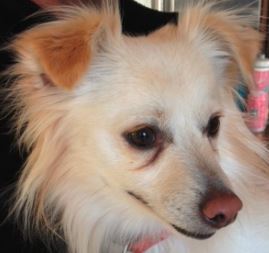Tear staining is a common problem in dogs. Tears spill over the lower lid and run down the face causing a condition called epiphora. The moist environment creates a perfect home for bacteria to grow. The combination of moisture and bacteria stain the fur making the dog look like a football player with black patches under their eyes.
The two general causes of epiphora are either excessive tear production that overwhelms the drainage system or a problem with the drainage system such that it does not capture the tears.
- Excessive Tear Production: In my experience, excessive tear production is usually caused by irritation. Hair growing in the wrong place and rubbing on the cornea is often the cause. Eyelashes that grow in the wrong direction (distichiasis) and lids that roll inward (entropion) are common. Since plucking the eyelash only provides temporary relief, offending lashes are removed with traditional or cryosurgery. Entropion can be caused by too much skin or an instability in the attachment of the corners of the lids. Both require surgical correction. In dogs with a lot of fur, trichiasis or excessive hair growth can cause epiphora. Long strands of facial hair touch the lids and eyes. Tears wick down the hair following the path of least resistance. A trip to the groomer will usually solve the problem.
2. Abnormal Drainage System: Problems with the drainage of tears is common in small dogs with large eyes. Normally, tears are collected in the lacrimal lake. It is a sac-like area created by the lower eyelid. The tears then exit through the nasalacrimal duct. There are many problems that can occur in this system including:
- Large eyeballs with tight eyelids. This condition takes all the slack out of the lower lid destroying the lacrimal lake.
- Imperforate puncta. The opening of the tear duct is called a puncta. Some dogs are born with a membrane over the opening. I see this most commonly in golden retrievers and cocker spaniels although it is reported in other breeds as well. The membrane is removed with surgery.
- Blocked nasolacrimal ducts. Dogs can have all kinds of problems with their nasolacrimal or tear ducts. Some are born with problems while others develop them. Small stones or debris can block the system. To remove, the duct is flushed with saline. I have also seen the duct blocked or narrowed from infections in the nose or tooth roots. The condition may or may not resolve when the infection is treated.
There are many products sold over-the-counter for the treatment of epiphora. Some contain bleach which burns the skin and eyes! Please do not use these. Others contain antibiotics but those can lead to bacterial resistance and superbugs. Others, do not provide a complete ingredient list making it impossible to tell if the product is safe and effective. Therefore, I do not recommend any over-the-counter tear staining products. If the cause of the tear staining cannot be corrected, then daily cleaning is the best therapy. Clean the skin to remove debris and then pat dry with a cotton ball.
Source:
Morgan, R. ‘Epiphora’. Associate Database, VIN, last updated 11/7/2007.
